TOYOTA LAND CRUISER 2018 Owners Manual (in English)
Manufacturer: TOYOTA, Model Year: 2018, Model line: LAND CRUISER, Model: TOYOTA LAND CRUISER 2018Pages: 620, PDF Size: 12.04 MB
Page 561 of 620
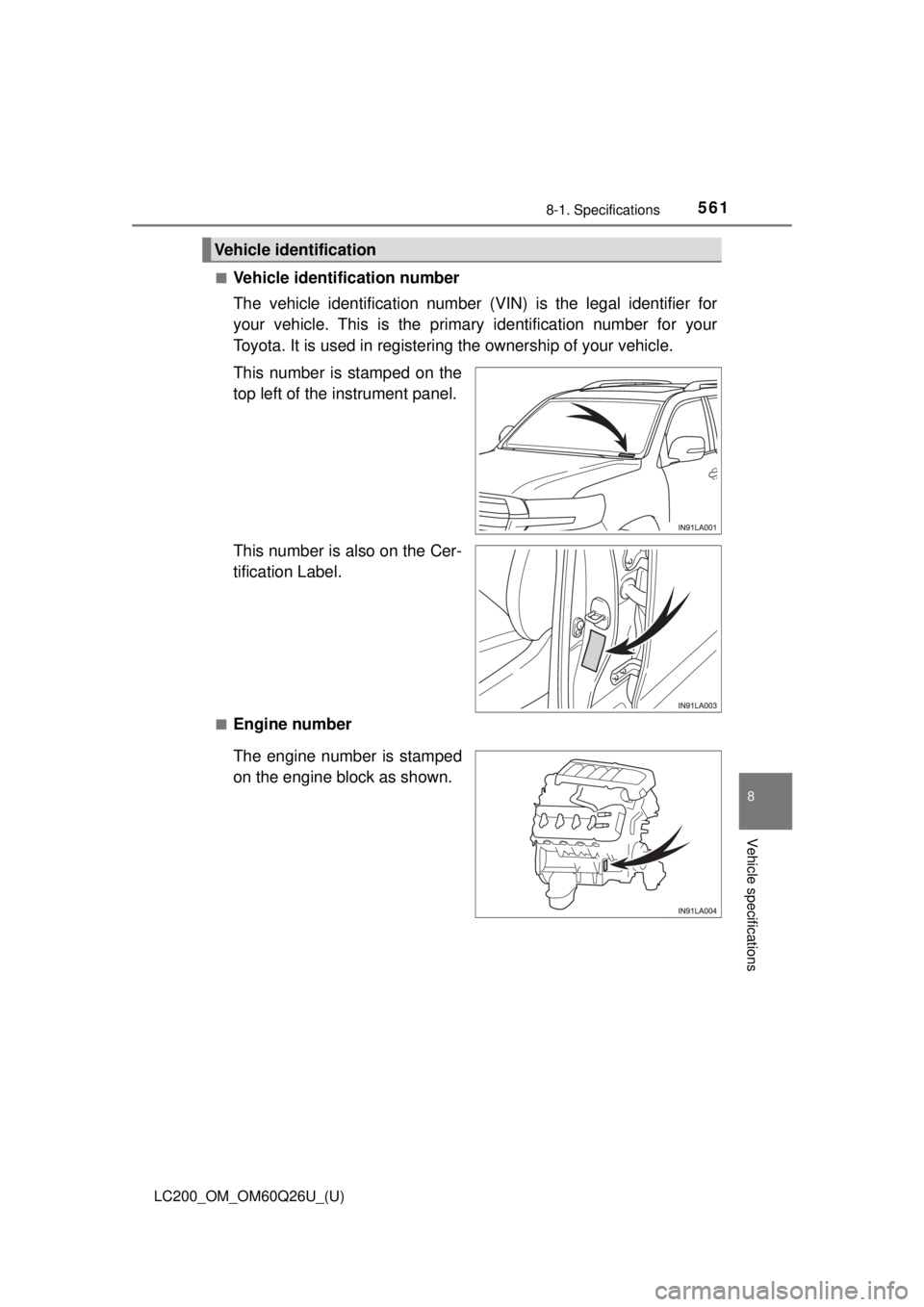
LC200_OM_OM60Q26U_(U)
5618-1. Specifications
8
Vehicle specifications
■Vehicle identification number
The vehicle identification number (VIN) is the legal identifier for
your vehicle. This is the primary identification number for your
Toyota. It is used in registering the ownership of your vehicle.
This number is stamped on the
top left of the instrument panel.
This number is also on the Cer-
tification Label.
■Engine number
The engine number is stamped
on the engine block as shown.
Vehicle identification
Page 562 of 620
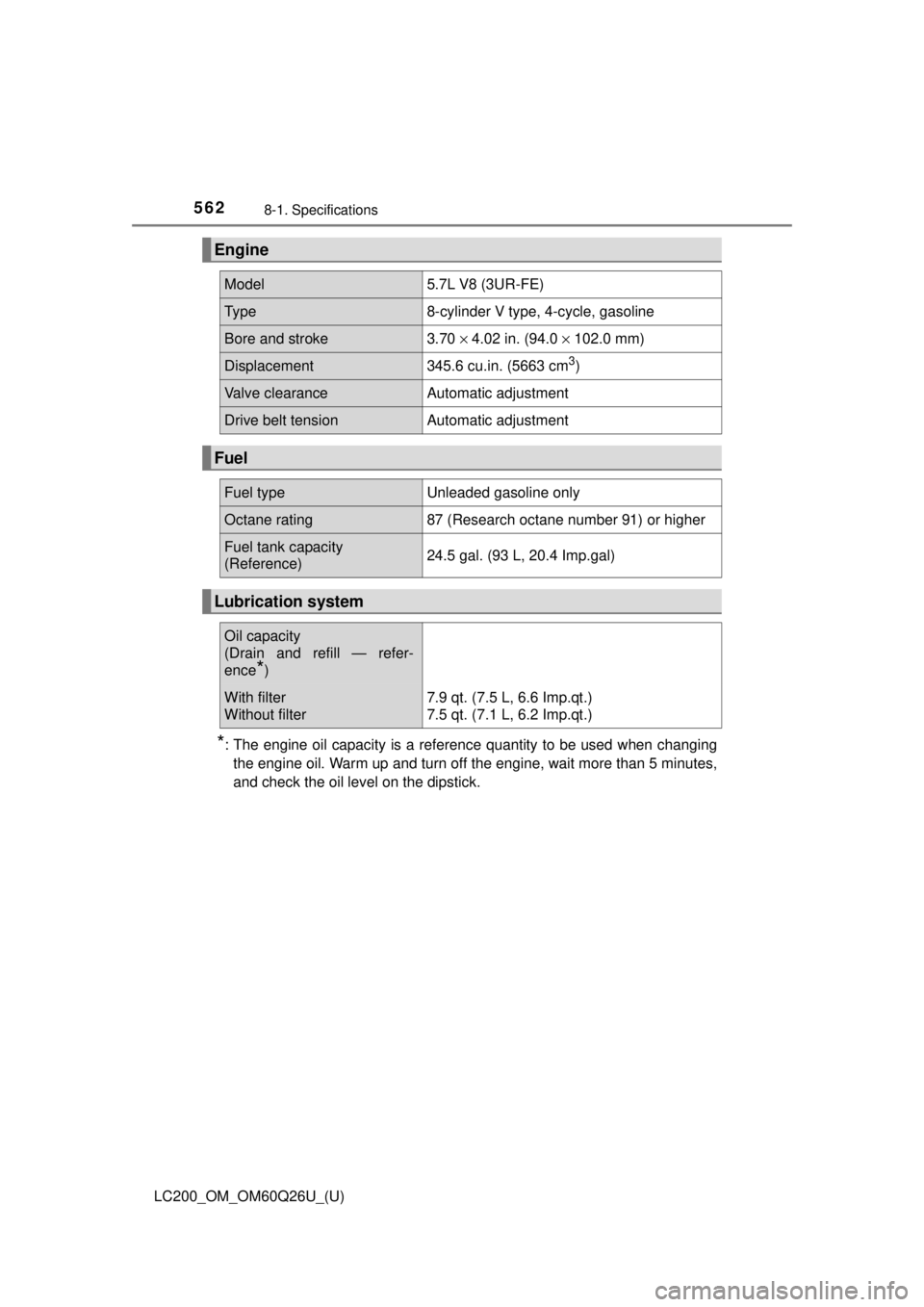
562
LC200_OM_OM60Q26U_(U)
8-1. Specifications
*: The engine oil capacity is a reference quantity to be used when changingthe engine oil. Warm up and turn off the engine, wait more than 5 minutes,
and check the oil level on the dipstick.
Engine
Model5.7L V8 (3UR-FE)
Ty p e8-cylinder V type, 4-cycle, gasoline
Bore and stroke3.70 × 4.02 in. (94.0 × 102.0 mm)
Displacement345.6 cu.in. (5663 cm3)
Valve clearanceAutomatic adjustment
Drive belt tensionAutomatic adjustment
Fuel
Fuel typeUnleaded gasoline only
Octane rating87 (Research octane number 91) or higher
Fuel tank capacity
(Reference)24.5 gal. (93 L, 20.4 Imp.gal)
Lubrication system
Oil capacity
(Drain and refill — refer-
ence
*)
With filter
Without filter7.9 qt. (7.5 L, 6.6 Imp.qt.)
7.5 qt. (7.1 L, 6.2 Imp.qt.)
Page 563 of 620
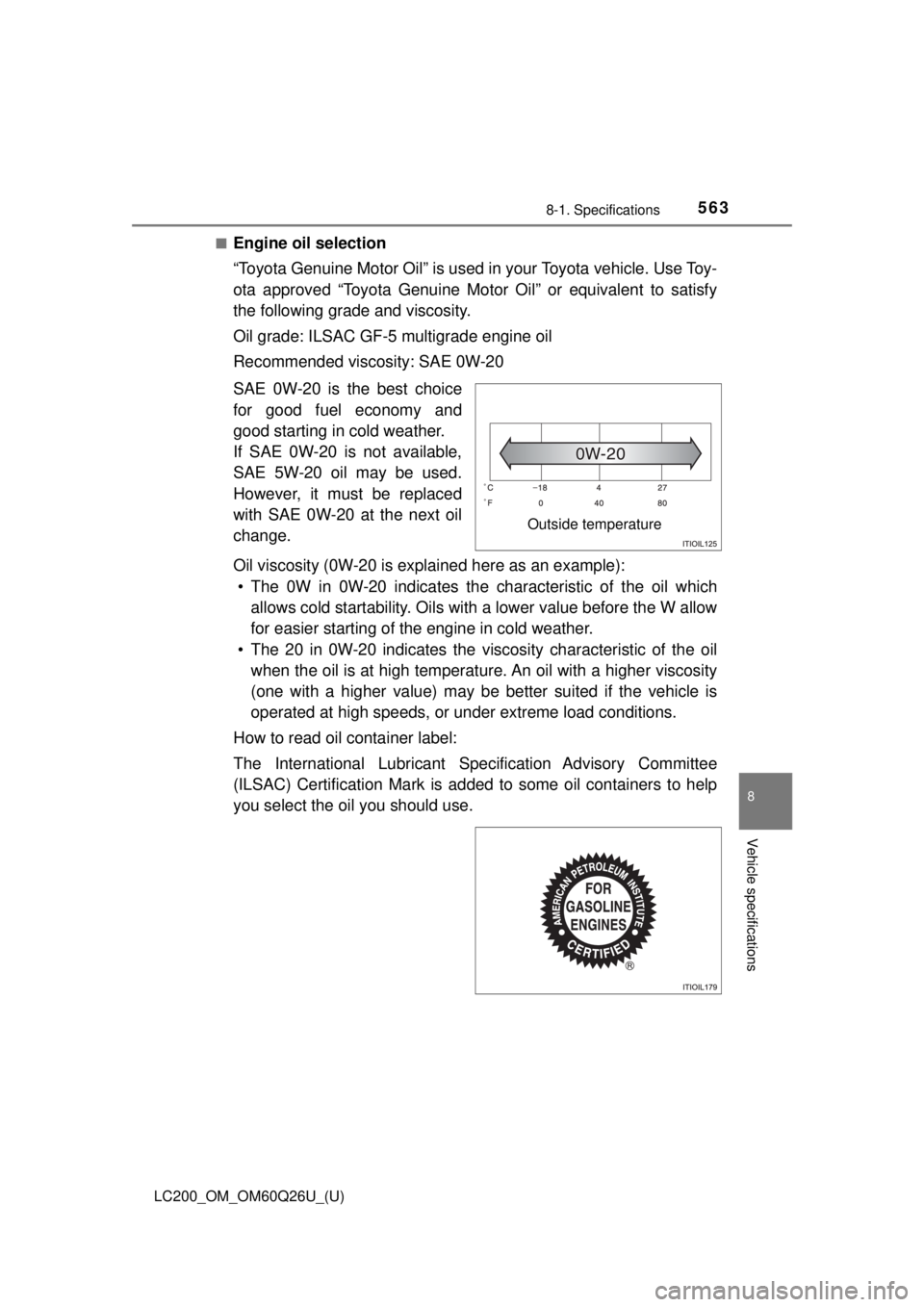
LC200_OM_OM60Q26U_(U)
5638-1. Specifications
8
Vehicle specifications
■Engine oil selection
“Toyota Genuine Motor Oil” is used in your Toyota vehicle. Use Toy-
ota approved “Toyota Genuine Motor Oil” or equivalent to satisfy
the following grade and viscosity.
Oil grade: ILSAC GF-5 multigrade engine oil
Recommended viscosity: SAE 0W-20
SAE 0W-20 is the best choice
for good fuel economy and
good starting in cold weather.
If SAE 0W-20 is not available,
SAE 5W-20 oil may be used.
However, it must be replaced
with SAE 0W-20 at the next oil
change.
Oil viscosity (0W-20 is explained here as an example): • The 0W in 0W-20 indicates the characteristic of the oil which
allows cold startability. Oils with a lower value before the W allow
for easier starting of the engine in cold weather.
• The 20 in 0W-20 indicates the viscosity characteristic of the oil when the oil is at high temperature. An oil with a higher viscosity
(one with a higher value) may be better suited if the vehicle is
operated at high speeds, or under extreme load conditions.
How to read oil container label:
The International Lubricant Sp ecification Advisory Committee
(ILSAC) Certification Mark is ad ded to some oil containers to help
you select the oi l you should use.
Outside temperature
Page 564 of 620
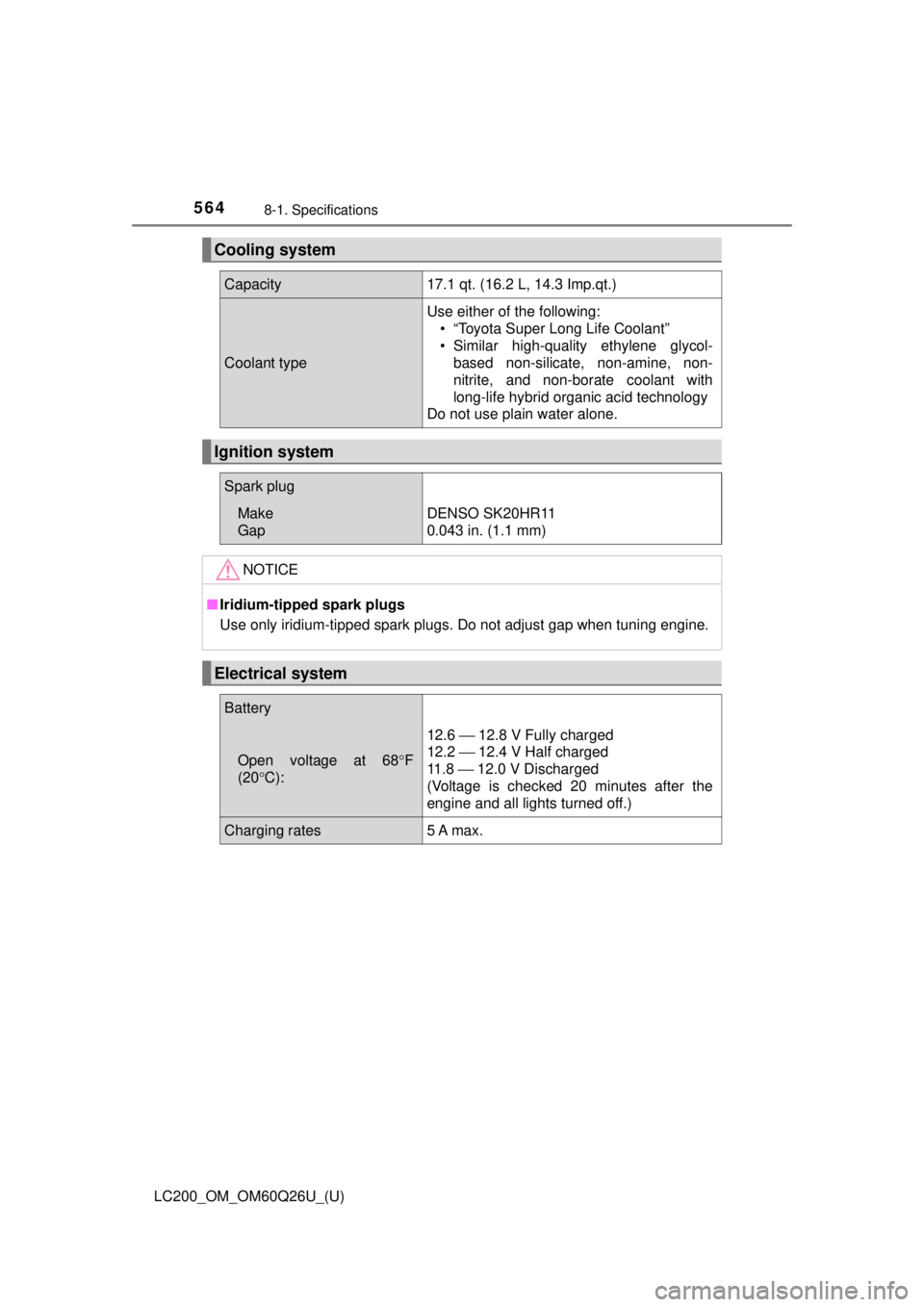
564
LC200_OM_OM60Q26U_(U)
8-1. Specifications
Cooling system
Capacity17.1 qt. (16.2 L, 14.3 Imp.qt.)
Coolant type
Use either of the following:• “Toyota Super Long Life Coolant”
• Similar high-quality ethylene glycol-based non-silicate, non-amine, non-
nitrite, and non-borate coolant with
long-life hybrid organic acid technology
Do not use plain water alone.
Ignition system
Spark plug
Make
GapDENSO SK20HR11
0.043 in. (1.1 mm)
NOTICE
■ Iridium-tipped spark plugs
Use only iridium-tipped spark plugs. Do not adjust gap when tuning engine.
Electrical system
Battery
Open voltage at 68 °F
(20° C):
12.6 ⎯ 12.8 V Fully charged
12.2 ⎯ 12.4 V Half charged
11 . 8 ⎯ 12.0 V Discharged
(Voltage is checked 20 minutes after the
engine and all lights turned off.)
Charging rates5 A max.
Page 565 of 620
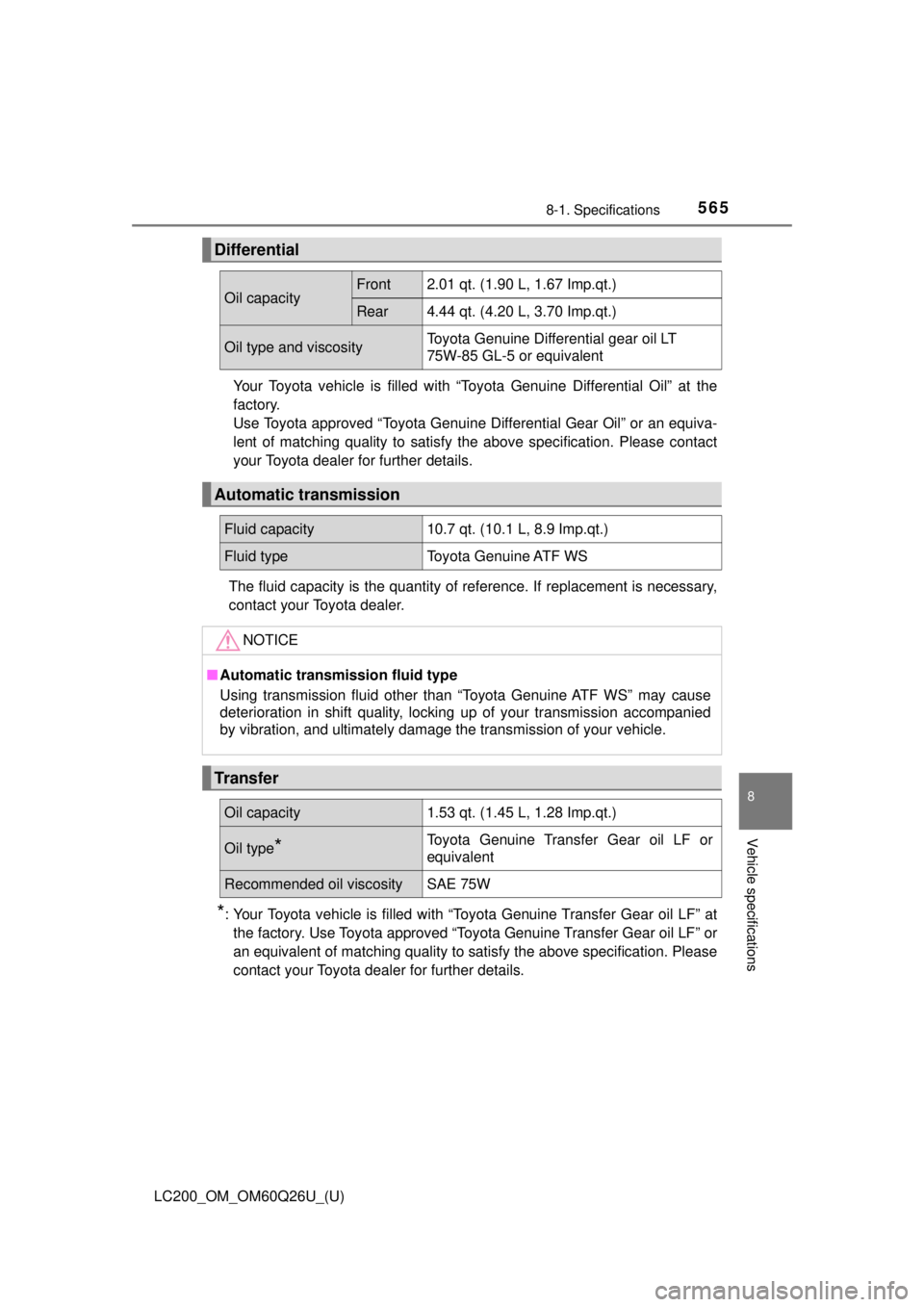
LC200_OM_OM60Q26U_(U)
5658-1. Specifications
8
Vehicle specifications
Your Toyota vehicle is filled with “Toyota Genuine Differential Oil” at the
factory.
Use Toyota approved “Toyota Genuine Differential Gear Oil” or an equiva-
lent of matching quality to satisfy the above specification. Please contact
your Toyota dealer for further details.
The fluid capacity is the quantity of reference. If replacement is necessary,
contact your Toyota dealer.
*: Your Toyota vehicle is filled with “Toyota Genuine Transfer Gear oil LF” at the factory. Use Toyota approved “Toyota Genuine Transfer Gear oil LF” or
an equivalent of matching quality to satisfy the above specification. Pl\
ease
contact your Toyota dealer for further details.
Differential
Oil capacityFront2.01 qt. (1.90 L, 1.67 Imp.qt.)
Rear4.44 qt. (4.20 L, 3.70 Imp.qt.)
Oil type and viscosityToyota Genuine Differential gear oil LT
75W-85 GL-5 or equivalent
Automatic transmission
Fluid capacity10.7 qt. (10.1 L, 8.9 Imp.qt.)
Fluid typeToyota Genuine ATF WS
NOTICE
■ Automatic transmission fluid type
Using transmission fluid other than “Toyota Genuine ATF WS” may cause
deterioration in shift quality, locking up of your transmission accompanied
by vibration, and ultimately damage the transmission of your vehicle.
Transfer
Oil capacity1.53 qt. (1.45 L, 1.28 Imp.qt.)
Oil type*Toyota Genuine Transfer Gear oil LF or
equivalent
Recommended oil viscositySAE 75W
Page 566 of 620
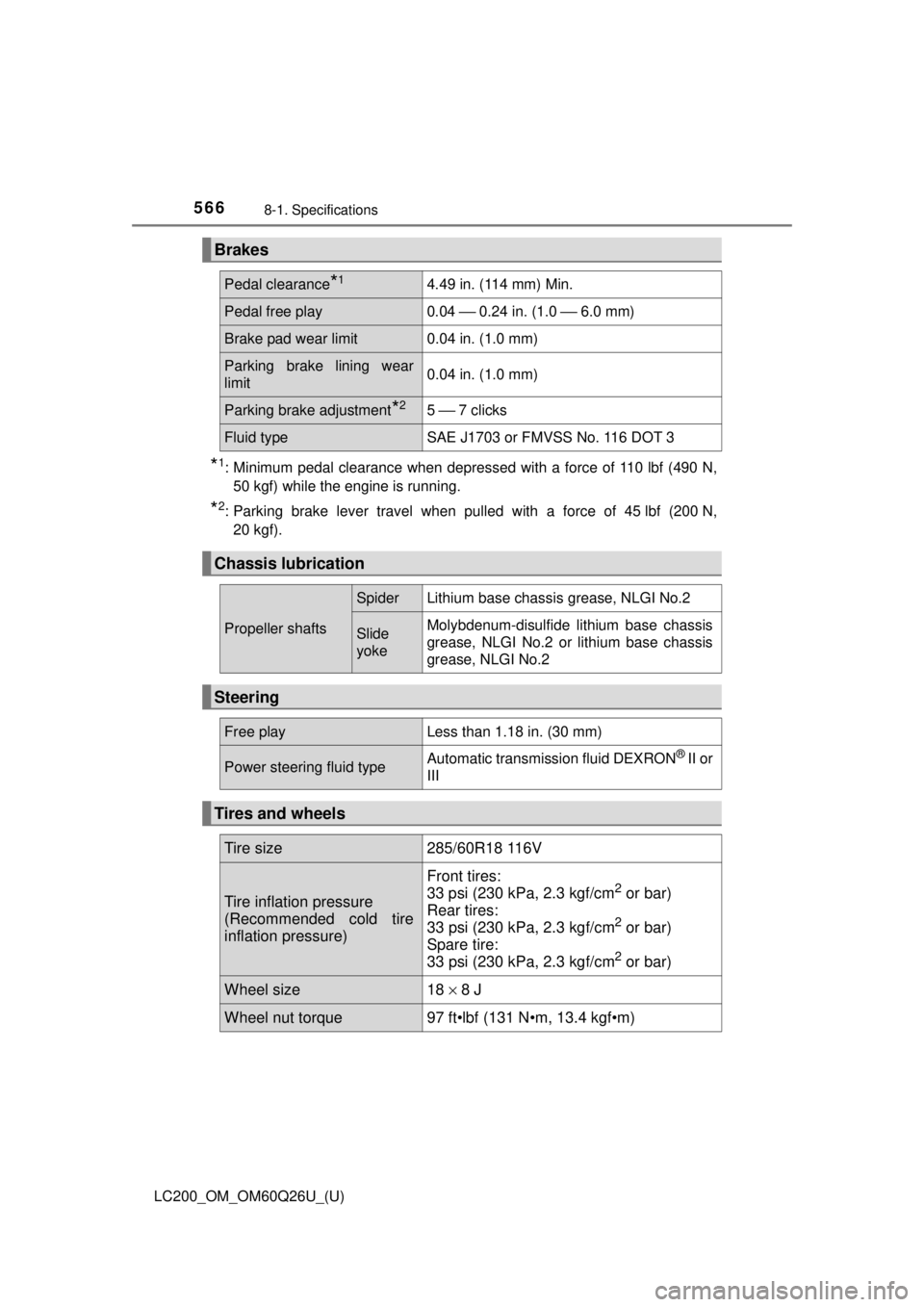
566
LC200_OM_OM60Q26U_(U)
8-1. Specifications
*1: Minimum pedal clearance when depressed with a force of 110 lbf (490 N,50 kgf) while the engine is running.
*2: Parking brake lever travel when pulled with a force of 45 lbf (200 N,20 kgf).
Brakes
Pedal clearance*14.49 in. (114 mm) Min.
Pedal free play0.04 ⎯ 0.24 in. (1.0 ⎯ 6.0 mm)
Brake pad wear limit0.04 in. (1.0 mm)
Parking brake lining wear
limit0.04 in. (1.0 mm)
Parking brake adjustment*25 ⎯ 7 clicks
Fluid typeSAE J1703 or FMVSS No. 116 DOT 3
Chassis lubrication
Propeller shafts
SpiderLithium base chassis grease, NLGI No.2
Slide
yokeMolybdenum-disulfide lithium base chassis
grease, NLGI No.2 or lithium base chassis
grease, NLGI No.2
Steering
Free playLess than 1.18 in. (30 mm)
Power steering fluid typeAutomatic transmission fluid DEXRON® II or
III
Tires and wheels
Tire size285/60R18 116V
Tire inflation pressure
(Recommended cold tire
inflation pressure)
Front tires:
33 psi (230 kPa, 2.3 kgf/cm2 or bar)
Rear tires:
33 psi (230 kPa, 2.3 kgf/cm
2 or bar)
Spare tire:
33 psi (230 kPa, 2.3 kgf/cm
2 or bar)
Wheel size18 × 8 J
Wheel nut torque97 ft•lbf (131 N•m, 13.4 kgf•m)
Page 567 of 620
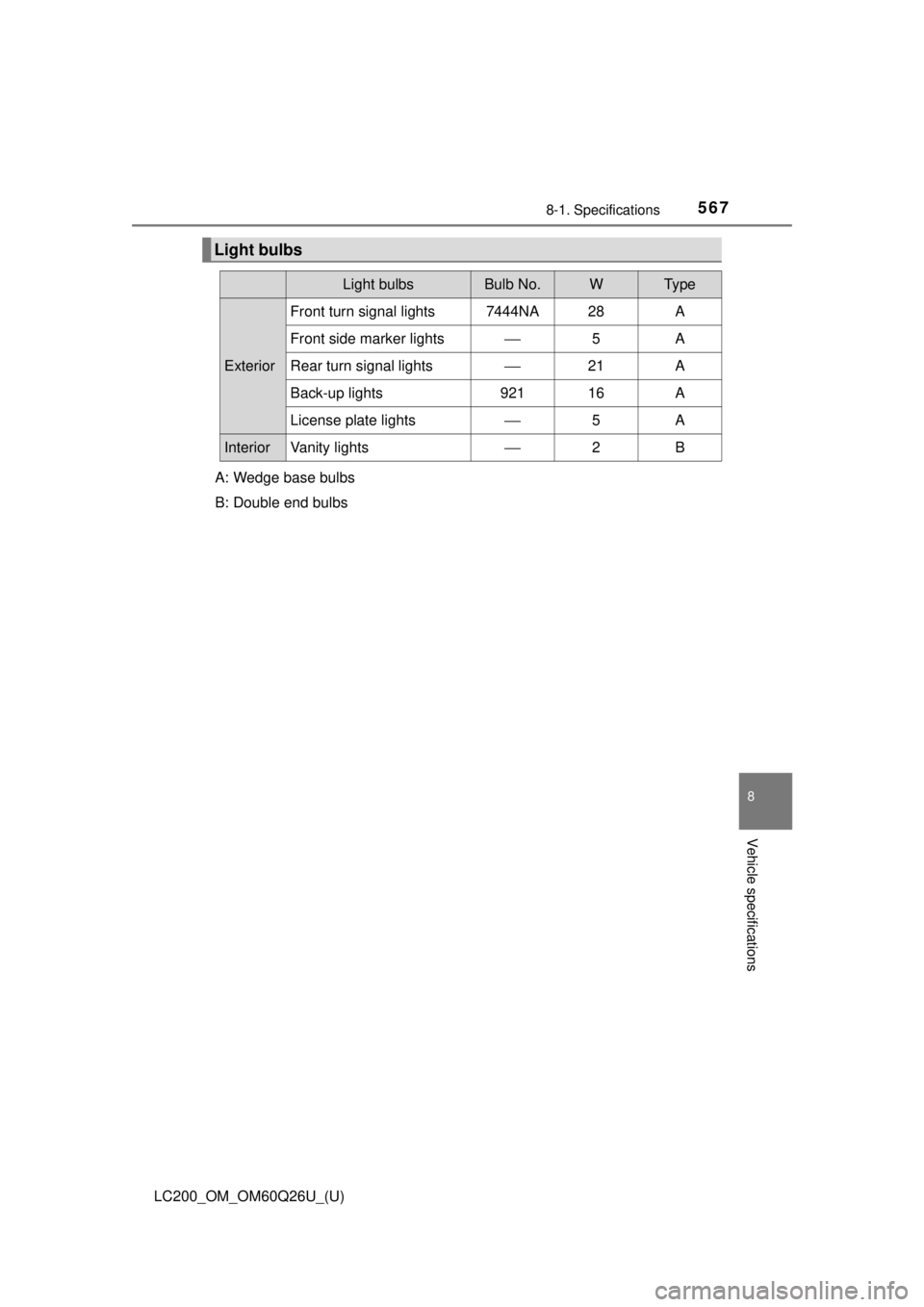
LC200_OM_OM60Q26U_(U)
5678-1. Specifications
8
Vehicle specifications
A: Wedge base bulbs
B: Double end bulbs
Light bulbs
Light bulbsBulb No.WTy p e
Exterior
Front turn signal lights7444NA28A
Front side marker lights⎯5A
Rear turn signal lights⎯21A
Back-up lights92116A
License plate lights⎯5A
InteriorVanity lights⎯2B
Page 568 of 620
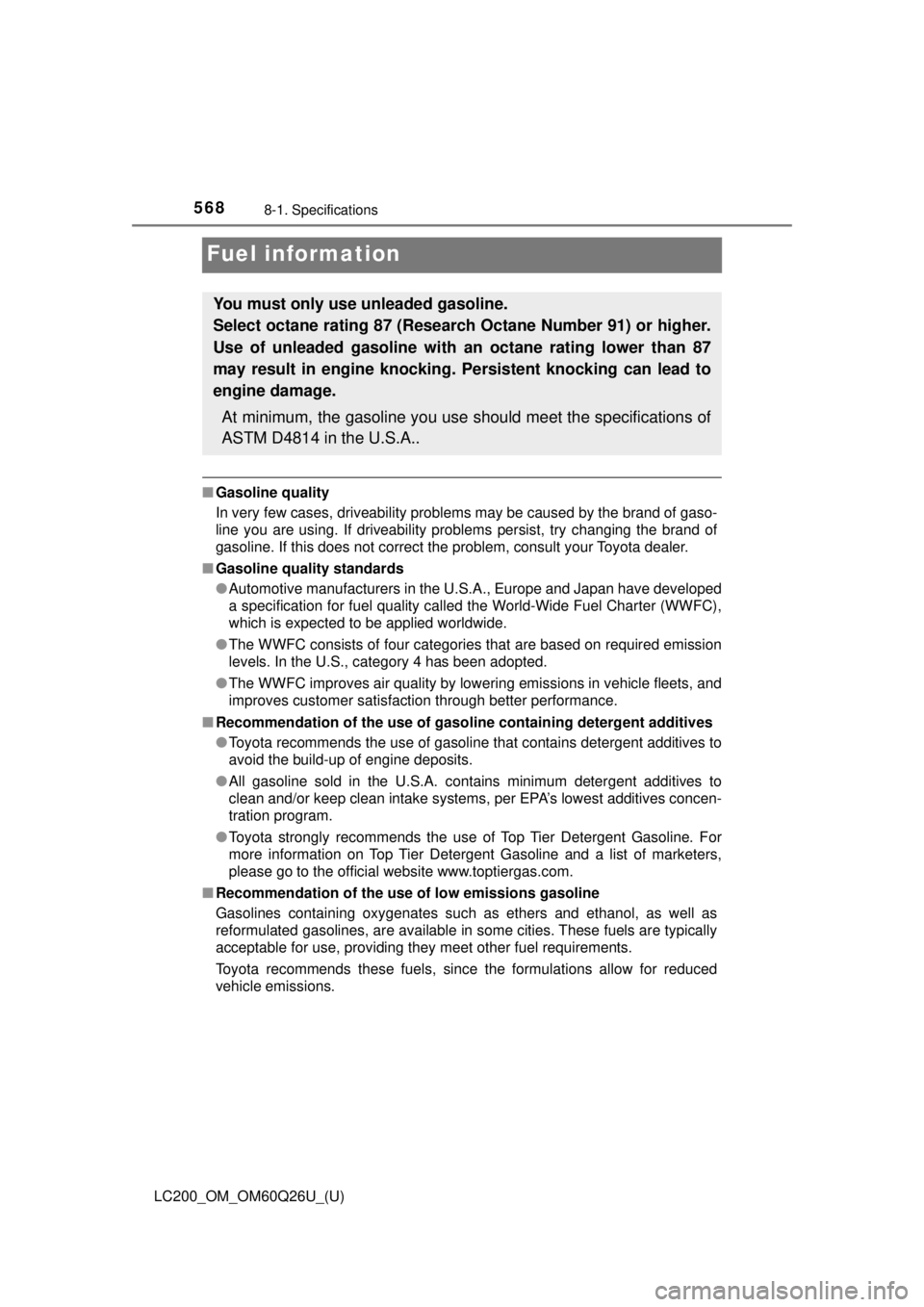
568
LC200_OM_OM60Q26U_(U)
8-1. Specifications
Fuel information
■Gasoline quality
In very few cases, driveability problems may be caused by the brand of gaso-
line you are using. If driveability problems persist, try changing the brand of
gasoline. If this does not correct the problem, consult your Toyota dealer.
■ Gasoline quality standards
●Automotive manufacturers in the U.S.A., Europe and Japan have developed
a specification for fuel quality called the World-Wide Fuel Charter (WWFC),
which is expected to be applied worldwide.
● The WWFC consists of four categor ies that are based on required emission
levels. In the U.S., category 4 has been adopted.
● The WWFC improves air quality by lowering emissions in vehicle fleets, and
improves customer satisfaction through better performance.
■ Recommendation of the use of gaso line containing detergent additives
● Toyota recommends the use of gasoline that contains detergent additives to
avoid the build-up of engine deposits.
● All gasoline sold in the U.S.A. contains minimum detergent additives to
clean and/or keep clean intake systems, per EPA’s lowest additives concen-
tration program.
● Toyota strongly recommends the use of Top Tier Detergent Gasoline. For
more information on Top Tier Detergent Gasoline and a list of marketers,
please go to the official website www.toptiergas.com.
■ Recommendation of the use of low emissions gasoline
Gasolines containing oxygenates such as ethers and ethanol, as well as
reformulated gasolines, are available in some cities. These fuels are typically
acceptable for use, providing they meet other fuel requirements.
Toyota recommends these fuels, since the formulations allow for reduced
vehicle emissions.
You must only use unleaded gasoline.
Select octane rating 87 (Research Octane Number 91) or higher.
Use of unleaded gasoline with an octane rating lower than 87
may result in engine knocking. Persistent knocking can lead to
engine damage.
At minimum, the gasoline you use s hould meet the specifications of
ASTM D4814 in the U.S.A..
Page 569 of 620
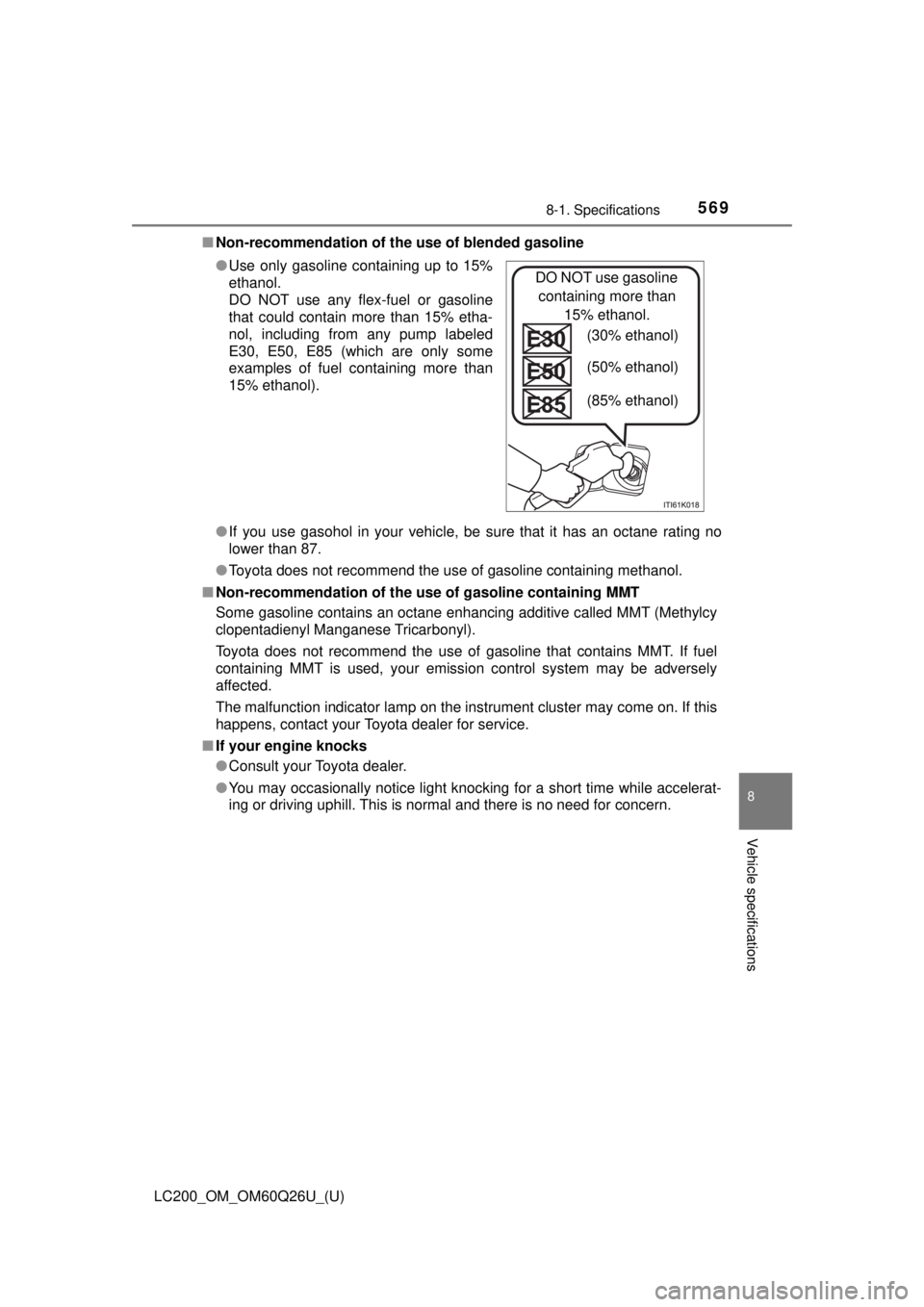
LC200_OM_OM60Q26U_(U)
5698-1. Specifications
8
Vehicle specifications
■Non-recommendation of the use of blended gasoline
●If you use gasohol in your vehicle, be sure that it has an octane rating no
lower than 87.
● Toyota does not recommend the use of gasoline containing methanol.
■ Non-recommendation of the use of gasoline containing MMT
Some gasoline contains an octane enhancing additive called MMT (Methylcy
clopentadienyl Manganese Tricarbonyl).
Toyota does not recommend the use of gasoline that contains MMT. If fuel
containing MMT is used, your emission control system may be adversely
affected.
The malfunction indicator lamp on the instrument cluster may come on. If this
happens, contact your Toyota dealer for service.
■ If your engine knocks
●Consult your Toyota dealer.
● You may occasionally notice light knocking for a short time while accelerat-
ing or driving uphill. This is normal and there is no need for concern.
●
Use only gasoline containing up to 15%
ethanol.
DO NOT use any flex-fuel or gasoline
that could contain more than 15% etha-
nol, including from any pump labeled
E30, E50, E85 (which are only some
examples of fuel containing more than
15% ethanol).
DO NOT use gasoline
containing more than 15% ethanol.
(30% ethanol)
(50% ethanol)
(85% ethanol)
Page 570 of 620
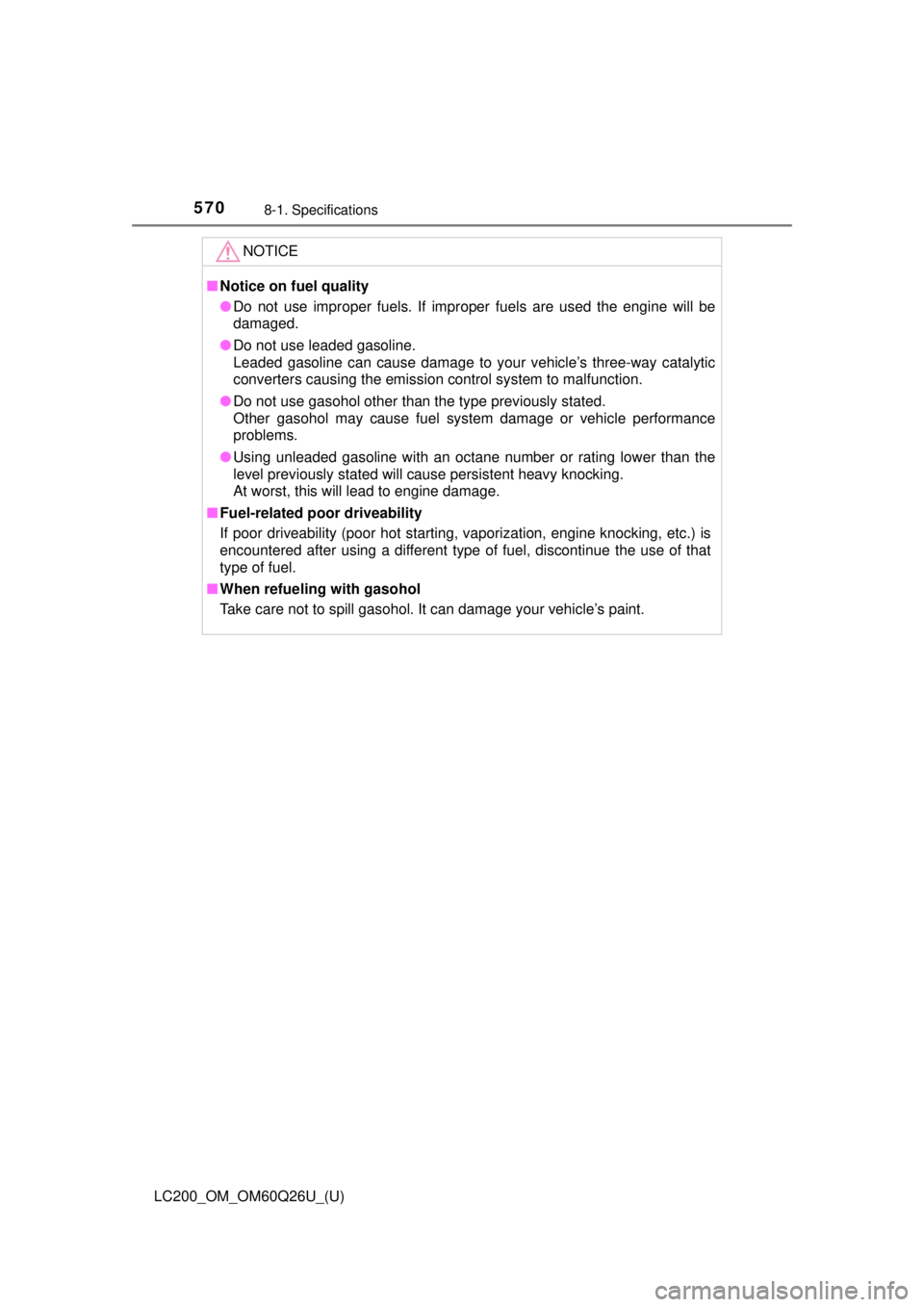
570
LC200_OM_OM60Q26U_(U)
8-1. Specifications
NOTICE
■Notice on fuel quality
● Do not use improper fuels. If improper fuels are used the engine will be
damaged.
● Do not use leaded gasoline.
Leaded gasoline can cause damage to your vehicle’s three-way catalytic
converters causing the emission control system to malfunction.
● Do not use gasohol other than the type previously stated.
Other gasohol may cause fuel system damage or vehicle performance
problems.
● Using unleaded gasoline with an octane number or rating lower than the
level previously stated will cause persistent heavy knocking.
At worst, this will lead to engine damage.
■ Fuel-related poor driveability
If poor driveability (poor hot starting, vaporization, engine knocking, etc.) is
encountered after using a different type of fuel, discontinue the use of that
type of fuel.
■ When refueling with gasohol
Take care not to spill gasohol. It can damage your vehicle’s paint.